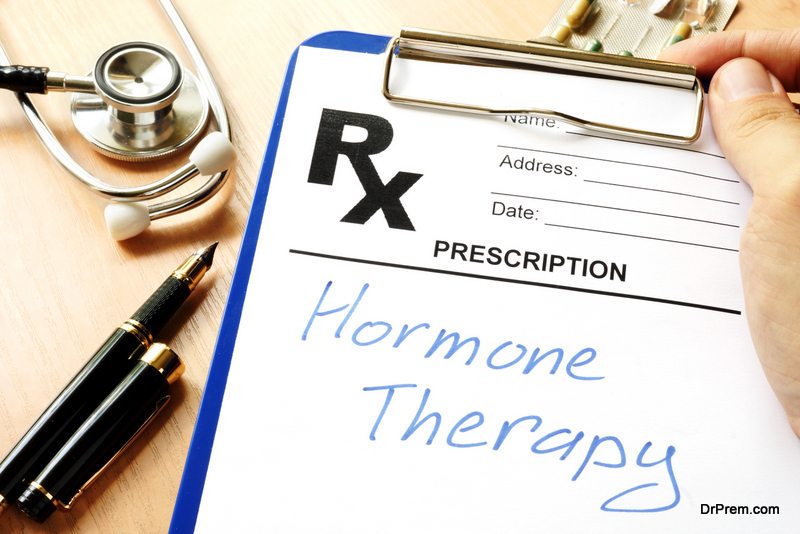If you are between the ages of 45 to 51 years and are going through an annoying state of postmenopausal symptoms – like hot flashes, vaginal dryness, night sweats, etc; you possibly have a reason to undergo postmenopausal hormonal therapy. Out of many different types of hormonal replacement therapies available currently, estrogen is considered to be the most effective in offering instant relief and hence frequently prescribed for managing symptoms.

A decision to choose an option of hormone replacement therapy should not be taken without medical supervision since even the most commonly prescribed formulation has synthetic hormones and hence, can increase the risk of many health issues – such as cancer, heart disease, etc. According to hormonal replacement therapy menopausal guidelines, one of the most common forms of HRT has been estimated to be associated with increased risk of breast cancer and cardiovascular problems like heart attacks, stroke, atherosclerosis etc; and hence, it is always advisable to undergo this postmenopausal hormonal therapy under expert medical supervision.
What are hormone replacement therapies?

Once women reach their menopause, their bodies tend to secrete reduced amount of female hormones such as estrogen and progesterone, which may lead to health issues – an excessive bone loss, vaginal dryness, mood swings, irritability, hot flashes, night sweating, vomiting, vaginal atrophy, etc. In this regard, postmenopausal hormonal therapy continues to play a leading role. Studies are supported by the fact that if taken in optimum doses, benefits of HRT have always appeared to outweigh its risks.
Thus, according to hormonal replacement therapy menopausal guidelines, two main hormones that are primarily used in HRT are:
- Oestrogen that is used in estradiol, estrone, and estriol
- Progesterone, another synthetic version of progesterone used under the brand of dydrogesterone, medroxyprogesterone, norethisterone, etc.
Depending upon symptomatic observation and physical condition, either one of the above mentioned or combined HRT is prescribed to many women.
As discussed earlier, before opting for HRT it is important to be aware of multiple risks and benefits associated with their use as well as which type of therapy is right for you. The article further intends to give you a brief overview about the same.
Risks and benefits associated with HRT
 Clinical studies around the globe have evidently proven that systemic administration of HRT under prescribed dosage can provide instant relief from postmenopausal health issues. Many women have reported reduced mood swings, regularized sleep pattern, improved sexual libido, and better quality of life after being treated with HRT.
Clinical studies around the globe have evidently proven that systemic administration of HRT under prescribed dosage can provide instant relief from postmenopausal health issues. Many women have reported reduced mood swings, regularized sleep pattern, improved sexual libido, and better quality of life after being treated with HRT.
According to the statistical analysis performed through Women Health Initiative trial in 2002 along with US food and drug administration; it is being conveyed that use of a synthetic version of hormone is associated with increased risk of breast cancer and cardiovascular diseases, like stroke, heart attack, etc. Thus, it is always advisable to use postmenopausal hormonal therapy with lowest effective dose for a very short time period. The guidelines also suggested that for women with increased risk of uterine cancer, progesterone should be prescribed along with estrogen, in order to offer maximum protection.
Ways of taking HRT
Just the decision to undergo HRT is not always enough. It is important to choose the right form of different HRT’s available like pills, patches, suppositories, etc. The choice is mostly dependent upon your current health status, personal preferences, and results that you wish to obtain from your treatment.
HRT Tablets
 These are the most commonly prescribed forms of HRT that are to be consumed once a day. As per the hormonal replacement therapy menopausal guidelines, either only estrogen tablets are prescribed or in combination with progesterone tablet can be offered, depending upon physical status and requirement. However, it is important to know that tablets can improve the chances of atherosclerosis and stroke.
These are the most commonly prescribed forms of HRT that are to be consumed once a day. As per the hormonal replacement therapy menopausal guidelines, either only estrogen tablets are prescribed or in combination with progesterone tablet can be offered, depending upon physical status and requirement. However, it is important to know that tablets can improve the chances of atherosclerosis and stroke.
Skin patches
These are also common ways of being on HRT. These patches can be worn and replaced after a gap of every few days. Again there are patches available only with estrogen or in combination with progesterone, depending upon the postmenopausal hormonal therapy you have been prescribed. These hormones are allowed to absorb slowly through the skin.
Application of skin patches is highly acknowledged over tablets, due to its convenience and availability. Research also indicated that use of these patches can reduce the risks of side effects.
Oestrogen gel

It is an increasingly popular form of HRT and is applied directly to the skin, to be absorbed through it and start working. Like skin patches, it is as well preferred due to its convenience and reduced associated risks.
Although variable products are available in the market, it is always advisable to consult your GP regarding your postmenopausal hormonal therapy and choose the best one for you depending on your physical need.


